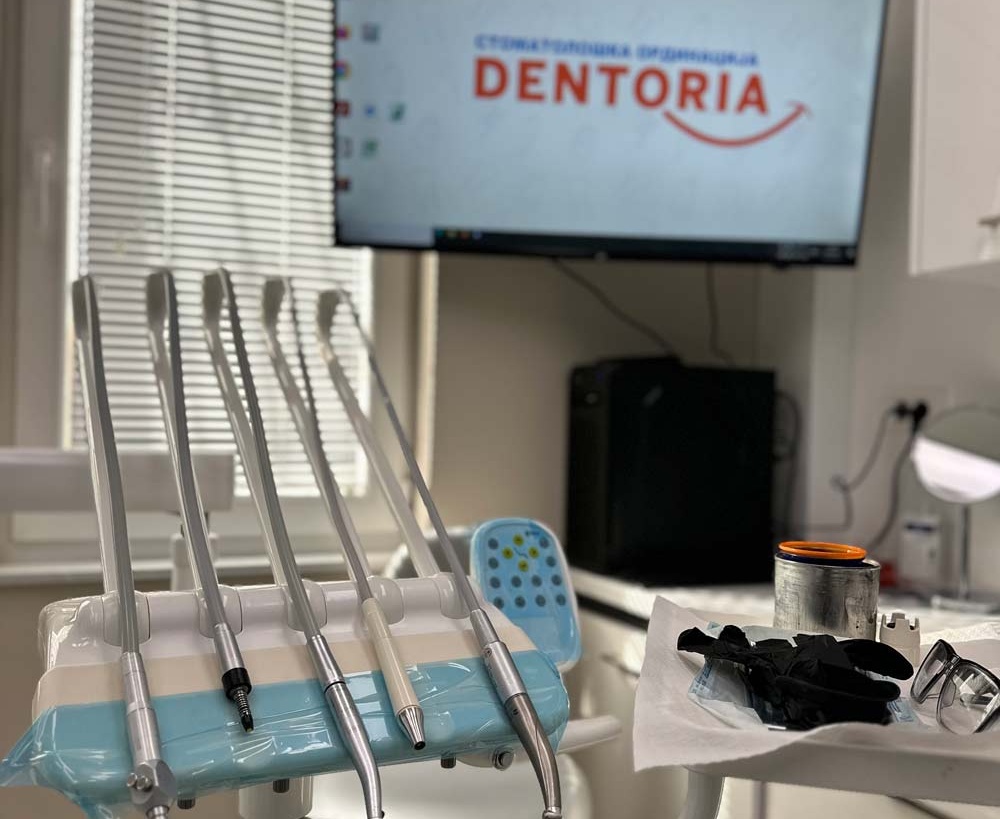
Composite fillings are a replacement for a portion of the natural tooth substance that has been lost for various reasons or to improve the unsatisfactory aesthetic appearance of the teeth. Composites are defined as a combination of two or more materials with properties that are better than those of the individual components.
Dentoria uses nanocomposites, which are the latest innovation in the field of composites. Due to the small particles, the aesthetic appearance of the restorations (fillings) is superior to other types of composites. The connection with the natural tooth is achieved by the composites with a bonding system, through a micromechanical connection.
The bond is taken with an applicator and the cavity is coated with it. With the help of a gentle jet of air, the bond is distributed throughout the cavity and thus penetrates the porosity (created spaces). The applied bond is illuminated with a halogen lamp for polymerization, after which the tooth surfaces where the bond was applied appear as if 'lacquered', which is an indicator of successful bonding.
At Dentoria we use the G-premio bond which has an advantage over others because it does not contain HEMA (2-Hydrohylethyl methacrylate), which is why it does not cause hydrolysis and thus does not change the color of the tooth. In addition to connecting the composite to the enamel and dentin of the tooth, it shows high bond strength values with metal and zirconia, which can also be used to correct your damaged bridges and crowns.
The next step is to choose the color of the composite, based on the color of the tooth. Traditional color shade systems are classified into groups (A, B, C, D) and graded from 1-4 (from the lightest to the darkest shade). However, there is a difference in the color of enamel and dentin, which also changes depending on the age of the patient. That is why we at Dentoria use Essentia composite systems, which consist of different color shades in just 7 syringes, with the layered application of which in just two layers, you will get a natural color of your filling that will not be distinguishable from the color of the natural tooth.
-
After selecting the color, the composite is applied, which requires an absolutely dry work area. The composite is applied layer by layer with a plastic instrument, with each layer being polymerized (lightened) separately. During the application, the tooth is simultaneously modeled with appropriate anatomical and morphological features, just like a natural tooth.
After the application of the composite filling is completed, the occlusion (the mutual contact of the teeth of both jaws) is checked, using articulation paper, to check whether there is proper contact of the filled tooth with the tooth of the opposite jaw. If the contact is premature, which the patient feels as a “high filling”, it is scraped and adjusted.
The final procedure is polishing the composite filling with a rubber and finishing strips to ensure a smooth surface.
The advantages of composites over amalgam are that they do not contain mercury, which is toxic to the body, and they have excellent aesthetics, which most closely mimic the appearance of natural teeth.
The purpose of composite fillings is to restore lost tooth substance, thereby establishing the correct anatomical-morphological shape of the tooth, restoring the lost chewing function, speech, and aesthetics of your teeth, and thus providing you with a healthy and beautiful smile.
Note: After the placement of a composite filling, it is possible to experience post-treatment hypersensitivity (mild pain), as a result of acid flushing, and thus rapid movement of fluid into the dentin tubules (one of the tooth tissues). The sensitivity can last up to several days, but then disappears.
They are composites to which small amounts of glass ionomer components have been added. The purpose of this material is to maintain the aesthetics and strength of the compositions, while at the same time obtaining the release of fluorides, which is a property of glass ionomer components and which prevents the occurrence of caries in patients with a high risk of caries.
Compomers
At Dentoria, we use the EQUIA restorative system (fillings), which is highly biocompatible (does not cause adverse reactions in the body), with improved mechanical properties - resistance to breakage and high aesthetic properties with a wide range of colors, identical to your natural teeth. It also releases fluorides, making it suitable for use in patients with a high risk of caries. It is indicated for use in all age groups.